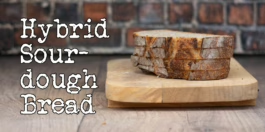The wind is tugging at the yellowing leaves on the trees. The earthy, moist, and somewhat decaying smells of nature. The leaves rustle on the ground as you walk through them. The chill wind on your face, as you take a brisk walk. Can you tell that I love fall? This is my recipe for sourdough pumpkin bread.
Pumpkins are a surefire sign of fall and also Halloween. In Denmark celebrating Halloween is a tradition that came back in the new Millenium. Although it was celebrated before the 20th Century, when it came back it was the America-inspired Halloween.
Full of Ghouls, Ghosts and Goblins, and yes, sexy nurses, and pumpkins galore.
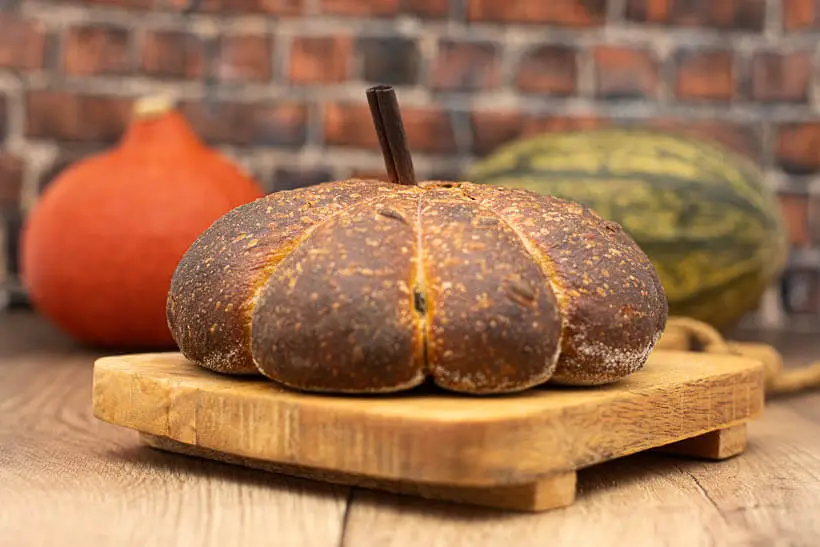
If you are just here for the recipe, you can press the button underneath to be automagically transported to the recipe:
Jump to Recipe Jump to VideoThe dough in this sourdough pumpkin bread recipe
The vitals
| Total weight | 1534 grams |
| Pre-fermented flour | 9.1% |
| Hydration | 70% |
| Yield | 2 small boules |
The dough
The dough for this pumpkin bread is wheat dough. 80% bread flour and 20% whole grain wheat flour.
It contains pumpkin purée which is another name for canned pumpkin. I use the Libby branded pumpkin purée which is the same that I use for pumpkin pie.
Since it’s shaped like a pumpkin, I also add pumpkin seeds, which is a delicious chewy addition.
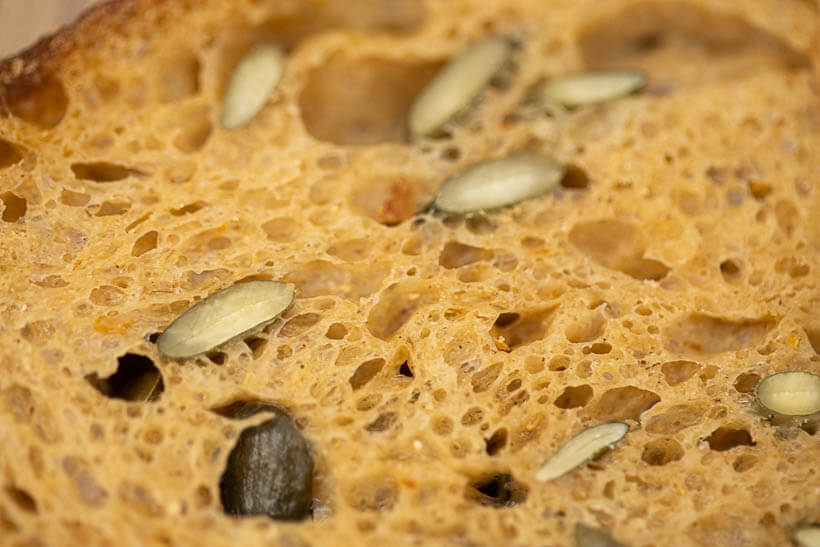
I make the bread with 70% hydration, but since pumpkin purée is about 90% hydration, you may want to lower that to 60% or 65%.
You can easily add more water, but it’s hard to take out again, so I suggest you start with 60% and knead the dough all the way through, and then decide if the dough needs more water.
The dough should be pretty stiff.
The salt is at 2.2% to get that delicious pumpkin flavor to the top.
The inoculation is 20%. If your kitchen is on the cold side you may want to up it to 30%.
| Weight | Ingredient | Baker's Percentage |
|---|---|---|
| 535g | bread flour | 80.0% |
| 134g | whole grain wheat flour | 20.0% |
| 448g | water | 67.0% |
| 134g | sourdough starter (100% hydration) | 20.0% |
| 15g | salt | 2.2% |
| 134g | pumpkin, canned | 20.0% |
| 134g | pumpkin seeds | 20.0% |
If you want to play with the formula, change quantity, hydration, inoculation, or other parameters, you can do that here in my Bread Calculator.
The conclusion
This bread evokes the same feelings as all the things in the introduction to this article. It’s the epitome of fall.
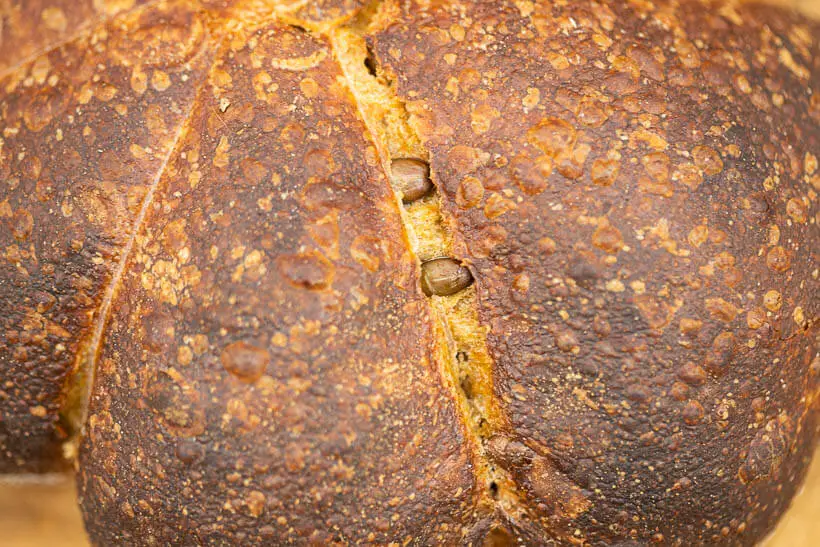
The smell of pumpkin and cinnamon coming off of the bread as it comes out of the oven is absolutely intoxicating.
The crust is super thin and crispy. The crumb is extremely soft and the chewy pumpkin seeds that are scattered throughout give a wonderful crunch.
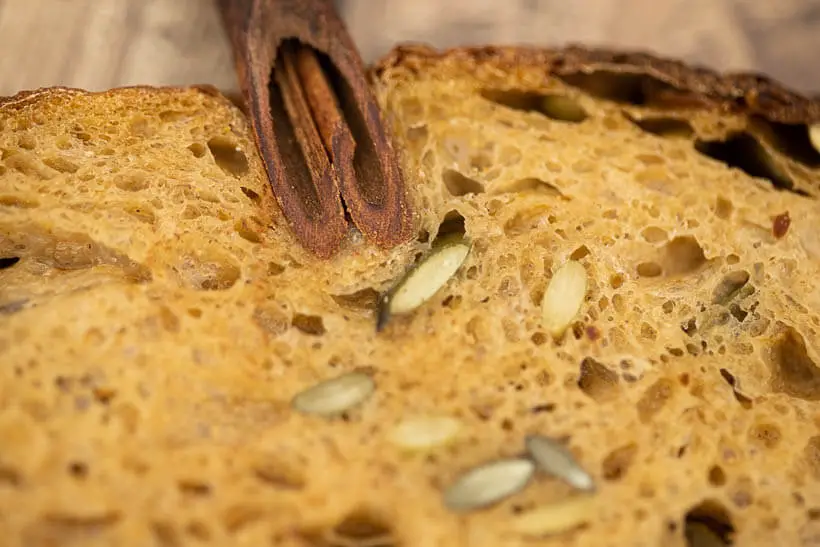
This bread goes with almost anything you can come up with, both sweet and savory.
It goes well with butter and jam, cheeses, meats, and an absolute favorite here at home is a toasted piece with cinnamon butter melted into the bread. Oh my freakin’ God.
So, go ahead and make it. It’s fall and it’s time for fall-inspired bread.
Please share this recipe for sourdough pumpkin bread on social media
This is my recipe for sourdough pumpkin bread. If you like the recipe please consider sharing it with like-minded bread lovers on social media.
If you make it and post it on Instagram, please tag me as @foodgeek.dk so I can see it. That would make me very happy.
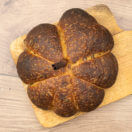
Pumpkin Sourdough Bread
Ingredients
Dough
- 535 g bread flour
- 134 g whole wheat flour
- 448 g water
- 134 g sourdough starter
- 15 g salt
- 134 g canned pumpkin puree
Soaker
- 134 g pumpkin seeds
- boiling water, as needed
Decoration
- 2 cinnamon sticks
Instructions
Mix the dough
- Add 535g bread flour, 134g whole-grain wheat flour and 15g salt to a bowl.
- Mix it with your hands to combine.
- Add 134g canned pumpkin and 134g active sourdough starter (fed and grown to its peak).
- Add 448g water. If you are opting for 65% hydration add 411g water, and if you are opting for 60% hydration add 374g water. The safe route is to start at the lower hydration and then add more water.
- It does take a while for the water to leak out of the pumpkin, so make sure you are careful.
- Mix until there is no dry flour left.
- Let the dough rest covered for one hour.
Create the soaker
- Add 134g pumpkin seeds to a small bowl and pour over boiling water until they are covered.
- Leave until you need it.
Bulk fermentation
- Strain the water from the seeds and include them during the first set of stretch and folds.
- Perform three sets of stretch and folds spaced out by 30 minutes.
- After the last set, do a windowpane test. If the dough doesn't pass the test, leave it for another 30 minutes, and then move on.
- If the dough passes, put it in a see-through bulking container with straight sides.
- Let the dough grow about 75%. We let it grow more because we don't want explosive oven spring as we usually do.
Divide and pre-shape
- Move the dough to your kitchen counter. Divide the dough into two equally sized pieces.
- Pre-shape each piece of dough into a boule (see the video for technique).
- Let them rest on the counter for 20 minutes.
Final shape
- Final-shape each ball into a taut boule.
- Put them in 7-inch round bannetons and put each banneton in a plastic bag.
- Put them in the fridge for at least 8 hours, up to 48 hours.
Bake the bread
- Heat the oven to 230°C/450°F.
- Cut eight pieces of butcher's twine at about 35 cm/14 inches in length (you need four for each bread).
- Grab a dough from the fridge and dust the bottom liberally with rice flour. You don't want it to stick to the peel.
- Flip the dough onto the peel.
- Sneak a piece of string underneath the dough and tie it at the top. Not too tight, not too slack.
- Tie the other three strings so that the bread is divided into eighths.
- Stick a piece of whole cinnamon in the middle of the dough to resemble the stalk.
- Open the oven and move the dough to the dutch oven.
- Close the dutch oven and the oven and bake for 20 minutes.
- Then open the oven, remove the dutch oven's lid and bake 20 minutes to brown the bread.
- Take the bread out of the oven and place it on a wire rack.
- Repeat for the other bread.





